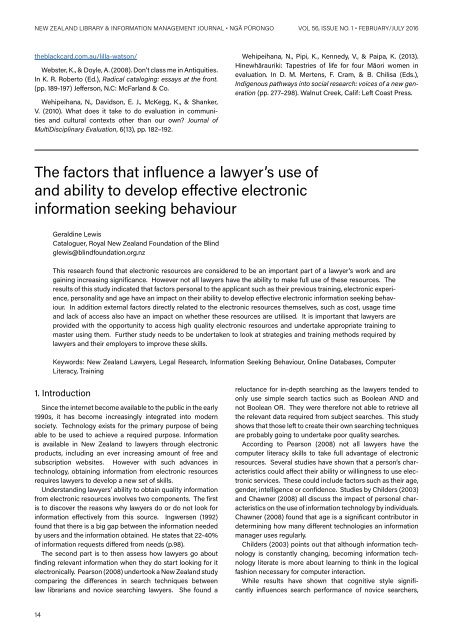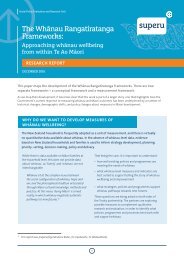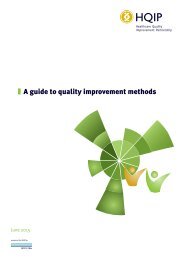THE NEW ZEALAND LIBRARY & INFORMATION MANAGEMENT JOURNAL NGĀ PŪRONGO
NZLIMJ%20FebJuly%202016
NZLIMJ%20FebJuly%202016
You also want an ePaper? Increase the reach of your titles
YUMPU automatically turns print PDFs into web optimized ePapers that Google loves.
<strong>NEW</strong> <strong>ZEALAND</strong> <strong>LIBRARY</strong> & <strong>INFORMATION</strong> <strong>MANAGEMENT</strong> <strong>JOURNAL</strong> • <strong>NGĀ</strong> <strong>PŪRONGO</strong> VOL 56, ISSUE NO. 1 • FEBRUARY/JULY 2016 <strong>NEW</strong> <strong>ZEALAND</strong> <strong>LIBRARY</strong> & <strong>INFORMATION</strong> <strong>MANAGEMENT</strong> <strong>JOURNAL</strong> • <strong>NGĀ</strong> <strong>PŪRONGO</strong> VOL 56, ISSUE NO. 1 • FEBRUARY/JULY 2016<br />
theblackcard.com.au/lilla-watson/<br />
Webster, K., & Doyle, A. (2008). Don’t class me in Antiquities.<br />
In K. R. Roberto (Ed.), Radical cataloging: essays at the front.<br />
(pp. 189-197) Jefferson, N.C: McFarland & Co.<br />
Wehipeihana, N., Davidson, E. J., McKegg, K., & Shanker,<br />
V. (2010). What does it take to do evaluation in communities<br />
and cultural contexts other than our own? Journal of<br />
MultiDisciplinary Evaluation, 6(13), pp. 182–192.<br />
The factors that influence a lawyer’s use of<br />
and ability to develop effective electronic<br />
information seeking behaviour<br />
Geraldine Lewis<br />
Cataloguer, Royal New Zealand Foundation of the Blind<br />
glewis@blindfoundation.org.nz<br />
Wehipeihana, N., Pipi, K., Kennedy, V., & Paipa, K. (2013).<br />
Hinewhārauriki: Tapestries of life for four Māori women in<br />
evaluation. In D. M. Mertens, F. Cram, & B. Chilisa (Eds.),<br />
Indigenous pathways into social research: voices of a new generation<br />
(pp. 277–298). Walnut Creek, Calif: Left Coast Press.<br />
This research found that electronic resources are considered to be an important part of a lawyer’s work and are<br />
gaining increasing significance. However not all lawyers have the ability to make full use of these resources. The<br />
results of this study indicated that factors personal to the applicant such as their previous training, electronic experience,<br />
personality and age have an impact on their ability to develop effective electronic information seeking behaviour.<br />
In addition external factors directly related to the electronic resources themselves, such as cost, usage time<br />
and lack of access also have an impact on whether these resources are utilised. It is important that lawyers are<br />
provided with the opportunity to access high quality electronic resources and undertake appropriate training to<br />
master using them. Further study needs to be undertaken to look at strategies and training methods required by<br />
lawyers and their employers to improve these skills.<br />
Keywords: New Zealand Lawyers, Legal Research, Information Seeking Behaviour, Online Databases, Computer<br />
Literacy, Training<br />
1. Introduction<br />
Since the internet become available to the public in the early<br />
1990s, it has become increasingly integrated into modern<br />
society. Technology exists for the primary purpose of being<br />
able to be used to achieve a required purpose. Information<br />
is available in New Zealand to lawyers through electronic<br />
products, including an ever increasing amount of free and<br />
subscription websites. However with such advances in<br />
technology, obtaining information from electronic resources<br />
requires lawyers to develop a new set of skills.<br />
Understanding lawyers’ ability to obtain quality information<br />
from electronic resources involves two components. The first<br />
is to discover the reasons why lawyers do or do not look for<br />
information effectively from this source. Ingwersen (1992)<br />
found that there is a big gap between the information needed<br />
by users and the information obtained. He states that 22-40%<br />
of information requests differed from needs (p.98).<br />
The second part is to then assess how lawyers go about<br />
finding relevant information when they do start looking for it<br />
electronically. Pearson (2008) undertook a New Zealand study<br />
comparing the differences in search techniques between<br />
law librarians and novice searching lawyers. She found a<br />
reluctance for in-depth searching as the lawyers tended to<br />
only use simple search tactics such as Boolean AND and<br />
not Boolean OR. They were therefore not able to retrieve all<br />
the relevant data required from subject searches. This study<br />
shows that those left to create their own searching techniques<br />
are probably going to undertake poor quality searches.<br />
According to Pearson (2008) not all lawyers have the<br />
computer literacy skills to take full advantage of electronic<br />
resources. Several studies have shown that a person’s characteristics<br />
could affect their ability or willingness to use electronic<br />
services. These could include factors such as their age,<br />
gender, intelligence or confidence. Studies by Childers (2003)<br />
and Chawner (2008) all discuss the impact of personal characteristics<br />
on the use of information technology by individuals.<br />
Chawner (2008) found that age is a significant contributor in<br />
determining how many different technologies an information<br />
manager uses regularly.<br />
Childers (2003) points out that although information technology<br />
is constantly changing, becoming information technology<br />
literate is more about learning to think in the logical<br />
fashion necessary for computer interaction.<br />
While results have shown that cognitive style significantly<br />
influences search performance of novice searchers,<br />
the influence is reduced in those that have online database<br />
experience (Palmiquist and Kim, 2000). Lawyers educated in<br />
the post internet era have been exposed to computers during<br />
their training; however their level of formal training may have<br />
been minimal. Many lawyers educated before the internet will<br />
be self-taught, while others will have learnt the minimum to<br />
get by.<br />
Jacobson and Fusani (1992) found that search experience<br />
and system knowledge were the critical factors in obtaining a<br />
successful search, rather than domain knowledge.<br />
Price (2006) found that seven out of ten employers thought<br />
that the information technology skills of their workforce had a<br />
significant impact on the success of their business. Yet only<br />
one in five companies was intending to do computer training<br />
for their staff in the following year.<br />
Not all lawyers will have access to the services of an information<br />
professional to undertake their research for them.<br />
Although the Law Society provides a legal research service<br />
where lawyers can pay a fee in return for research being done<br />
on their behalf, lawyers may choose not to take this up, for a<br />
variety of reasons. In order to be a learning organisation both<br />
lawyers and their employers need to know how they learn<br />
new skills in order to train them to be more computer literate<br />
(Goad, 2002).<br />
In addition to factors personal to the user, there are also<br />
attributes of an innovation intrinsic to it, that impact on the<br />
likelihood of it being adopted. Rogers (1962) outlines these in<br />
his Diffusion of Innovations theory.<br />
Chawner (2008) found that institutional barriers to the<br />
uptake of Web 2.0 in the workforce were raised as the most<br />
regular problem. This is often caused by security reasons and<br />
may be very difficult to change. According to Eveland (1986)<br />
most organisation decisions are not decided on the basis of<br />
the technology but rather on ‘finance, personal, scheduling<br />
and resource management’ (p. 11).<br />
A theoretical framework was developed for this study<br />
applying Ingwersen’s theory contained in his book, Information<br />
Retrieval Interaction (1992), that a combination of a traditional<br />
approach, a user-oriented and a cognitive approach are necessary<br />
in order to obtain optimum information retrieval for the<br />
searcher.<br />
In this book and the subsequent book by Ingwersen and<br />
Jàrvelin, The turn: Integration of information seeking and<br />
retrieval in context (2004) they theorise that the traditional<br />
approach to information retrieval is very technology focussed,<br />
concerned only with the information retrieved by each search<br />
and whether this directly relates to the search terms entered,<br />
with no consideration given to the needs of the end-user. They<br />
state this needs to be combined with the user-orientated and<br />
the cognitive approach to enable a searcher to obtain the best<br />
possible result in information seeking.<br />
This research uses the user-orientated and cognitive<br />
approach for its framework. The user-orientated approach<br />
focusses on the psychological and behavioural communication<br />
of information between the user and the system. This<br />
uses real life investigations of search behaviour to understand<br />
common patterns. The cognitive approach focusses on the<br />
individual cognitive, motivational and emotional activities<br />
inherent in all areas of information retrieval. It also looks at the<br />
social environment surrounding the act of retrieval. Ingwersen<br />
and Jàrvelin theorise that for information seeking and retrieval<br />
to take place “during communication of information any actor<br />
is influenced by their past and present experiences and their<br />
social, organisational and cultural environment” (p.25).<br />
There is also another aspect of this current research that is<br />
not covered by their theory. Everett Rogers (1962) Diffusion<br />
of Innovations theory is also used as a framework for looking<br />
at why an innovation such as computer technology is, or is<br />
not taken up. Rogers defines the following characteristics of<br />
innovations as reasons why users may adopt or reject them:<br />
• Relative advantage: i.e. how this innovation will<br />
improve the current situation.<br />
• Compatibility: How easy it will be to assimilate this<br />
innovation into the user’s life.<br />
• Complexity or Simplicity: How easy is it going to be<br />
to use it?<br />
After taking account of the literature on this topic the following<br />
research question has been developed:<br />
“What factors influence a lawyer’s use of and ability to<br />
develop effective electronic information seeking behaviour?”<br />
This study was restricted to practising lawyers in New<br />
Zealand. It was based on a convenience sample of nine lawyers.<br />
As this is a small number of people being studied, the<br />
results may not be generalisable. As this study only considered<br />
lawyers, it was a one off study, concerning a unique<br />
workforce. Artificial search tasks were created for this study<br />
which may lack some realism. Although all nine lawyers gave<br />
an oral description of how they would undertake a search task<br />
only two lawyers were observed doing so. The interviews rely<br />
on each lawyer’s personal interpretation of the question and<br />
also their memory of their previous actions, which may be<br />
flawed.<br />
2. Method<br />
This research aimed to understand an event from the<br />
viewpoint of the participants concerned and therefore used<br />
a phenomenological study design. Themes were developed<br />
from the answers given by the participants in accordance<br />
with Ingwersen and Jàrvelin and Rogers’ theories. This helped<br />
identify the factors influencing computer technology uptake<br />
by lawyers in New Zealand, in order to come to a conclusion<br />
over the best strategies and training methods for addressing<br />
any issues raised.<br />
This study used a purposive sample of nine lawyers in New<br />
Zealand, in order to give a small but in-depth picture of how<br />
lawyers obtain computer literacy skills. A diverse demographic<br />
range of lawyers participated. This involved lawyers<br />
from early in their careers, to lawyers who had worked for over<br />
twenty years; men and women; lawyers from several different<br />
regions in New Zealand; and also lawyers working in a variety<br />
of different workplaces.<br />
All participants were emailed a short questionnaire<br />
containing questions relating to their demographic background<br />
and self-assessment of their previous search experience.<br />
Secondly all participants were asked to take part in<br />
a semi-structured recorded interview, answering a series of<br />
questions. Two of the lawyers participated in a third method<br />
14 15






